2008 CHRYSLER TOWN AND COUNTRY catalytic converter
[x] Cancel search: catalytic converterPage 235 of 531
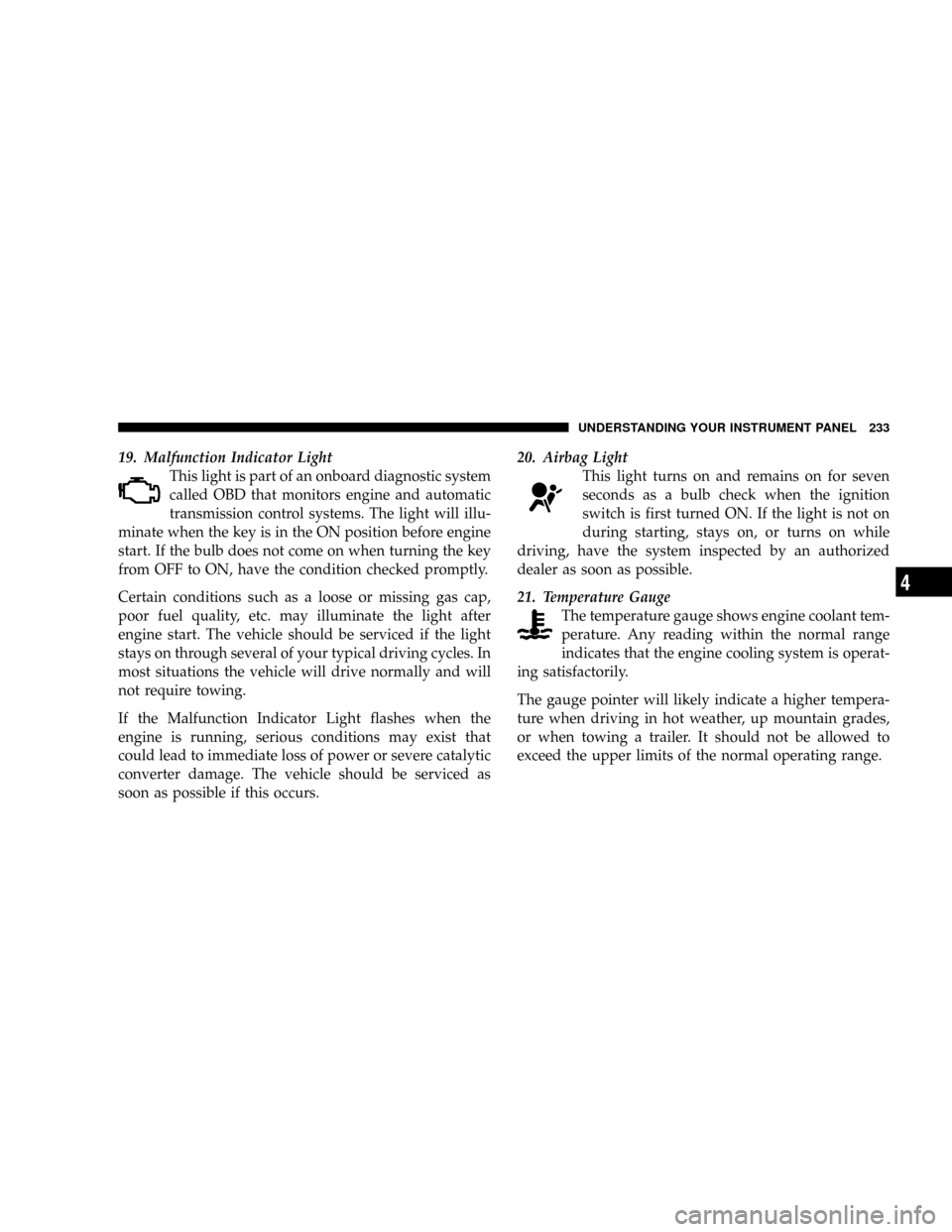
19. Malfunction Indicator Light
This light is part of an onboard diagnostic system
called OBD that monitors engine and automatic
transmission control systems. The light will illu-
minate when the key is in the ON position before engine
start. If the bulb does not come on when turning the key
from OFF to ON, have the condition checked promptly.
Certain conditions such as a loose or missing gas cap,
poor fuel quality, etc. may illuminate the light after
engine start. The vehicle should be serviced if the light
stays on through several of your typical driving cycles. In
most situations the vehicle will drive normally and will
not require towing.
If the Malfunction Indicator Light flashes when the
engine is running, serious conditions may exist that
could lead to immediate loss of power or severe catalytic
converter damage. The vehicle should be serviced as
soon as possible if this occurs.20. Airbag Light
This light turns on and remains on for seven
seconds as a bulb check when the ignition
switch is first turned ON. If the light is not on
during starting, stays on, or turns on while
driving, have the system inspected by an authorized
dealer as soon as possible.
21. Temperature Gauge
The temperature gauge shows engine coolant tem-
perature. Any reading within the normal range
indicates that the engine cooling system is operat-
ing satisfactorily.
The gauge pointer will likely indicate a higher tempera-
ture when driving in hot weather, up mountain grades,
or when towing a trailer. It should not be allowed to
exceed the upper limits of the normal operating range.
UNDERSTANDING YOUR INSTRUMENT PANEL 233
4
Page 330 of 531
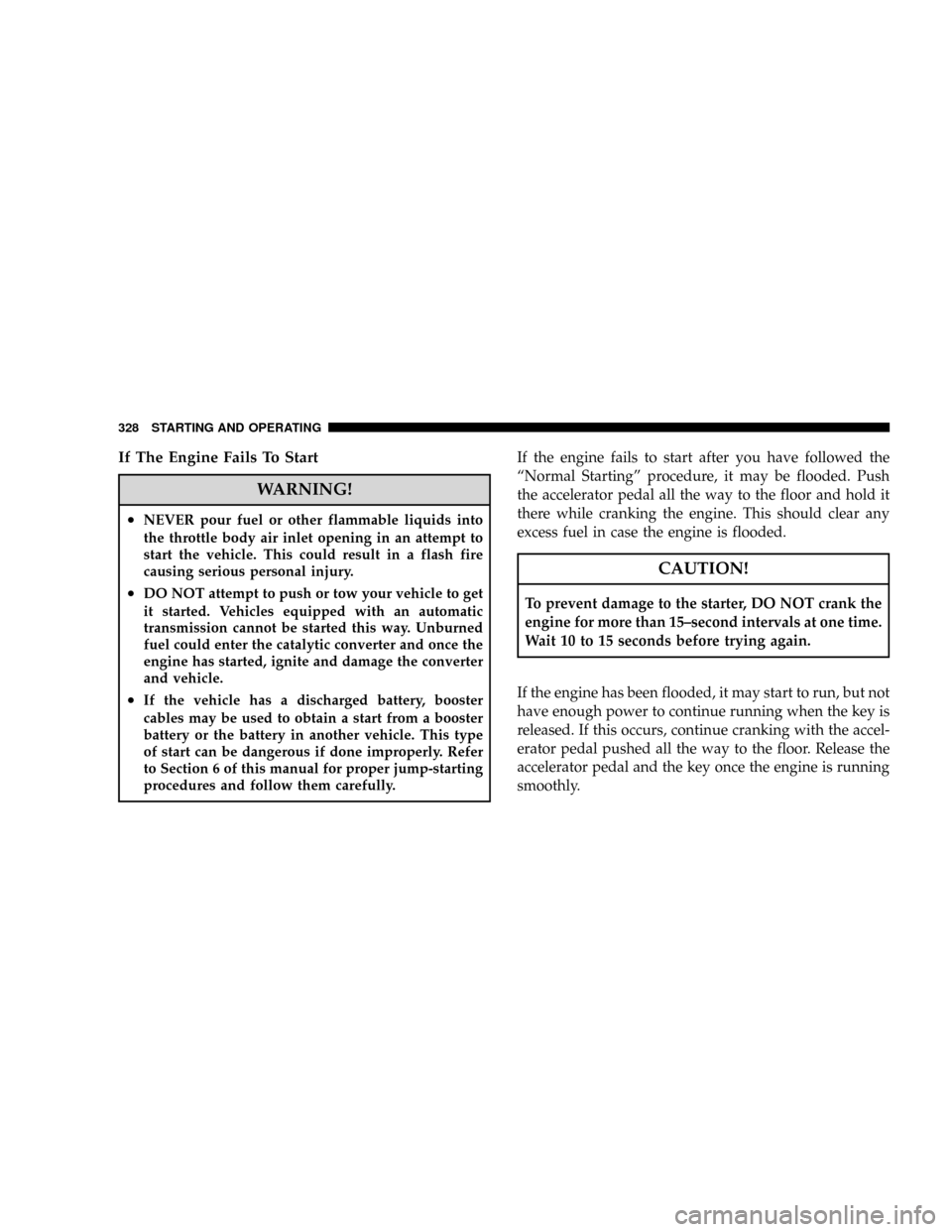
If The Engine Fails To Start
WARNING!
²NEVER pour fuel or other flammable liquids into
the throttle body air inlet opening in an attempt to
start the vehicle. This could result in a flash fire
causing serious personal injury.
²DO NOT attempt to push or tow your vehicle to get
it started. Vehicles equipped with an automatic
transmission cannot be started this way. Unburned
fuel could enter the catalytic converter and once the
engine has started, ignite and damage the converter
and vehicle.
²If the vehicle has a discharged battery, booster
cables may be used to obtain a start from a booster
battery or the battery in another vehicle. This type
of start can be dangerous if done improperly. Refer
to Section 6 of this manual for proper jump-starting
procedures and follow them carefully.
If the engine fails to start after you have followed the
ªNormal Startingº procedure, it may be flooded. Push
the accelerator pedal all the way to the floor and hold it
there while cranking the engine. This should clear any
excess fuel in case the engine is flooded.
CAUTION!
To prevent damage to the starter, DO NOT crank the
engine for more than 15±second intervals at one time.
Wait 10 to 15 seconds before trying again.
If the engine has been flooded, it may start to run, but not
have enough power to continue running when the key is
released. If this occurs, continue cranking with the accel-
erator pedal pushed all the way to the floor. Release the
accelerator pedal and the key once the engine is running
smoothly.
328 STARTING AND OPERATING
Page 384 of 531
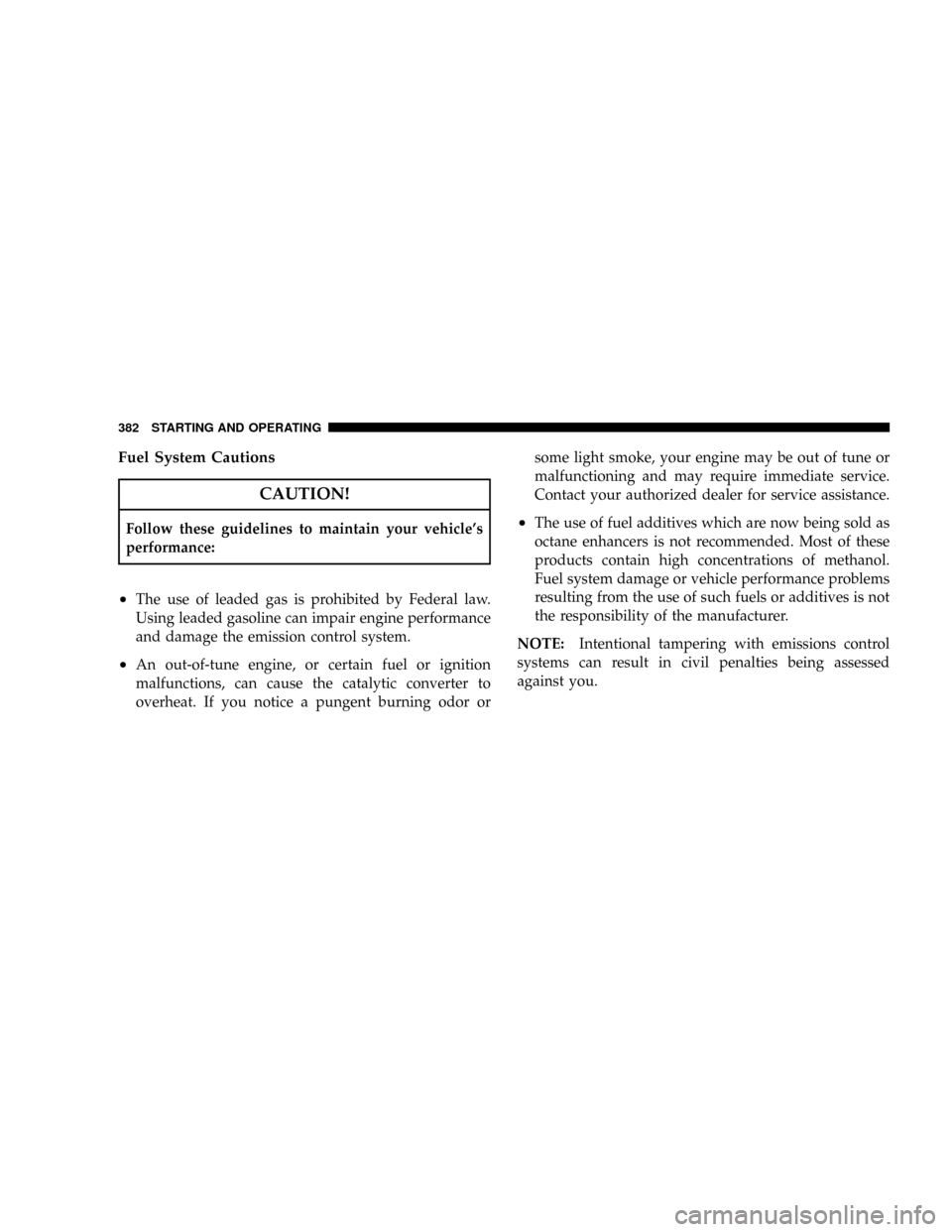
Fuel System Cautions
CAUTION!
Follow these guidelines to maintain your vehicle's
performance:
²The use of leaded gas is prohibited by Federal law.
Using leaded gasoline can impair engine performance
and damage the emission control system.
²An out-of-tune engine, or certain fuel or ignition
malfunctions, can cause the catalytic converter to
overheat. If you notice a pungent burning odor orsome light smoke, your engine may be out of tune or
malfunctioning and may require immediate service.
Contact your authorized dealer for service assistance.
²The use of fuel additives which are now being sold as
octane enhancers is not recommended. Most of these
products contain high concentrations of methanol.
Fuel system damage or vehicle performance problems
resulting from the use of such fuels or additives is not
the responsibility of the manufacturer.
NOTE:Intentional tampering with emissions control
systems can result in civil penalties being assessed
against you.
382 STARTING AND OPERATING
Page 426 of 531
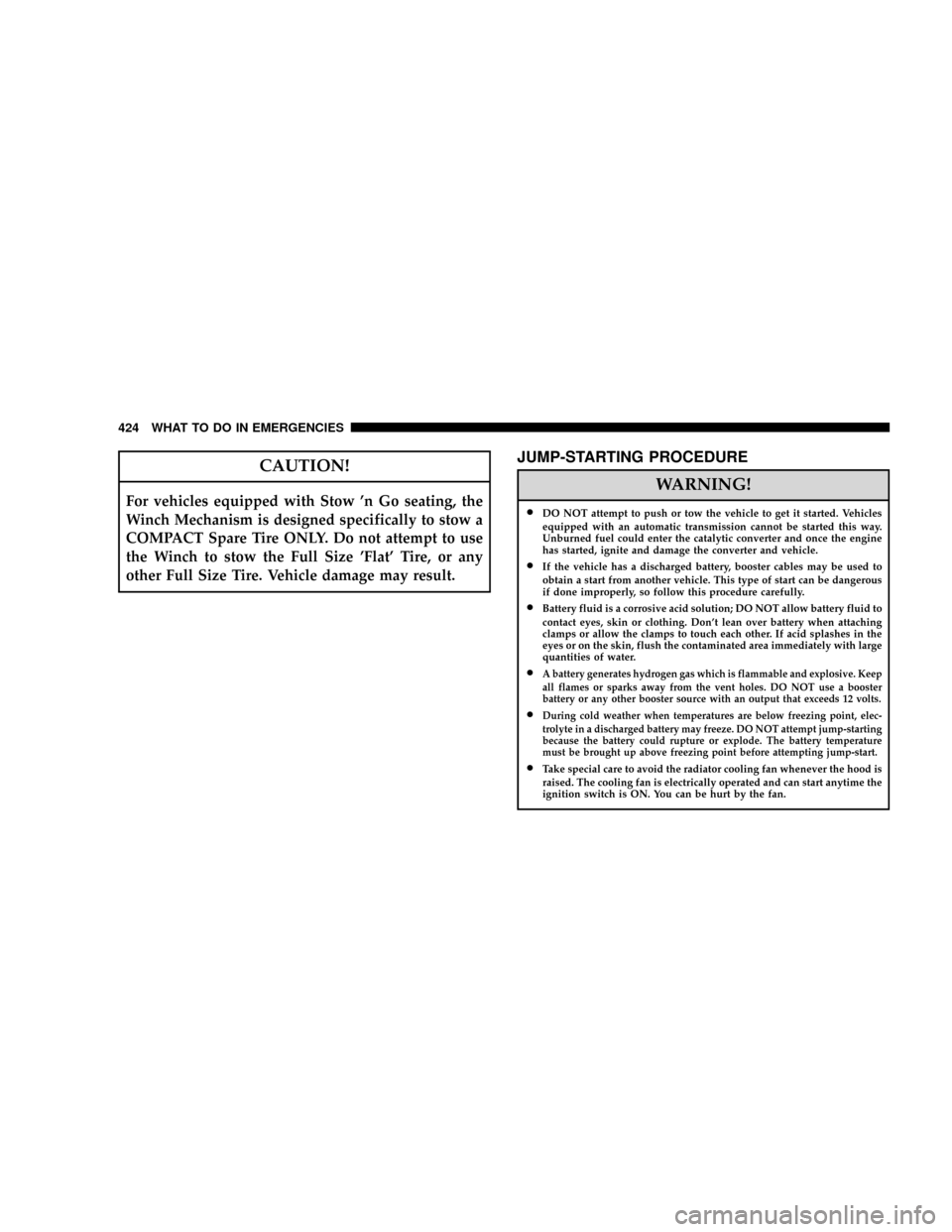
CAUTION!
For vehicles equipped with Stow 'n Go seating, the
Winch Mechanism is designed specifically to stow a
COMPACT Spare Tire ONLY. Do not attempt to use
the Winch to stow the Full Size 'Flat' Tire, or any
other Full Size Tire. Vehicle damage may result.
JUMP-STARTING PROCEDURE
WARNING!
²DO NOT attempt to push or tow the vehicle to get it started. Vehicles
equipped with an automatic transmission cannot be started this way.
Unburned fuel could enter the catalytic converter and once the engine
has started, ignite and damage the converter and vehicle.
²If the vehicle has a discharged battery, booster cables may be used to
obtain a start from another vehicle. This type of start can be dangerous
if done improperly, so follow this procedure carefully.
²Battery fluid is a corrosive acid solution; DO NOT allow battery fluid to
contact eyes, skin or clothing. Don't lean over battery when attaching
clamps or allow the clamps to touch each other. If acid splashes in the
eyes or on the skin, flush the contaminated area immediately with large
quantities of water.
²A battery generates hydrogen gas which is flammable and explosive. Keep
all flames or sparks away from the vent holes. DO NOT use a booster
battery or any other booster source with an output that exceeds 12 volts.
²During cold weather when temperatures are below freezing point, elec-
trolyte in a discharged battery may freeze. DO NOT attempt jump-starting
because the battery could rupture or explode. The battery temperature
must be brought up above freezing point before attempting jump-start.
²Take special care to avoid the radiator cooling fan whenever the hood is
raised. The cooling fan is electrically operated and can start anytime the
ignition switch is ON. You can be hurt by the fan.
424 WHAT TO DO IN EMERGENCIES
Page 431 of 531
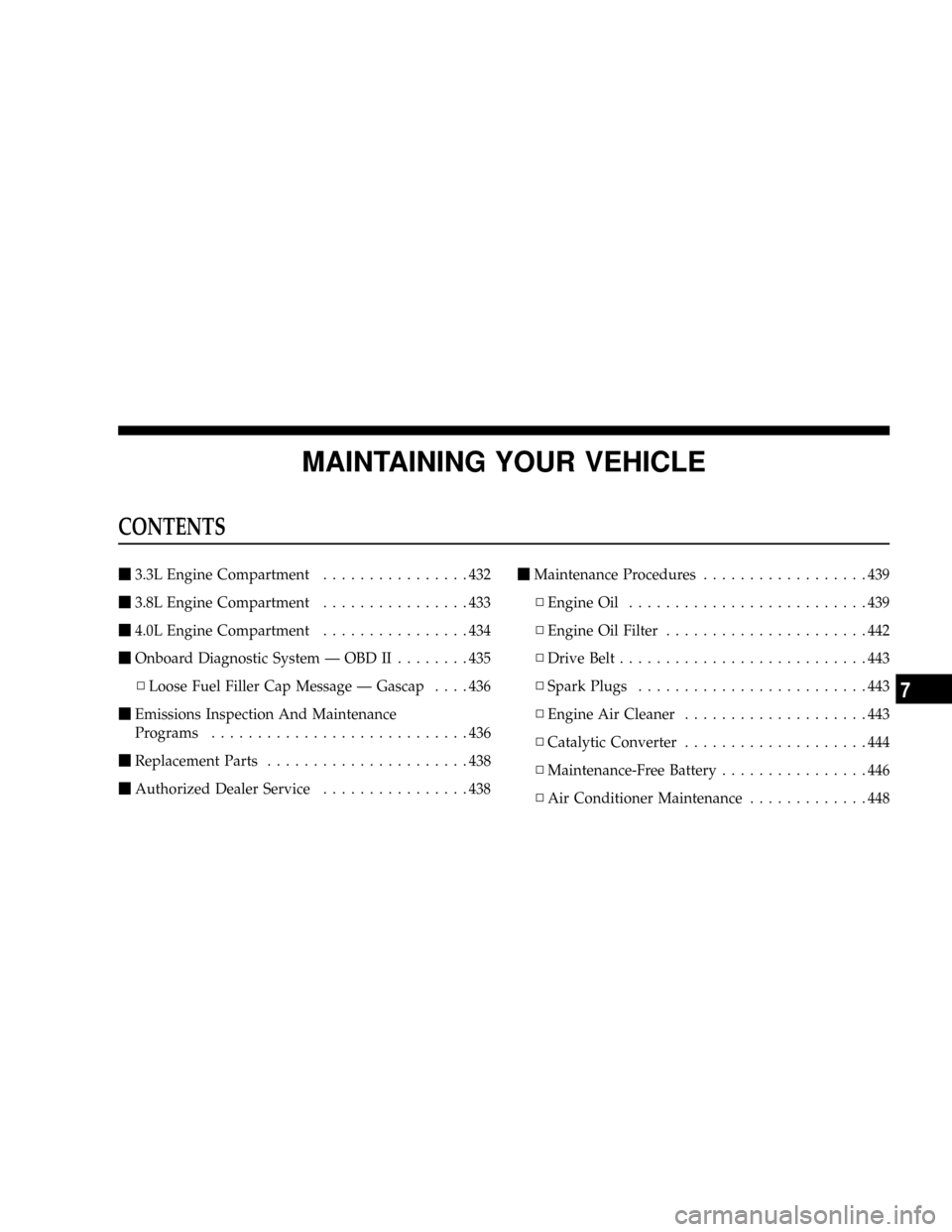
MAINTAINING YOUR VEHICLE
CONTENTS
m3.3L Engine Compartment................432
m3.8L Engine Compartment................433
m4.0L Engine Compartment................434
mOnboard Diagnostic System Ð OBD II........435
NLoose Fuel Filler Cap Message Ð Gascap....436
mEmissions Inspection And Maintenance
Programs............................436
mReplacement Parts......................438
mAuthorized Dealer Service................438mMaintenance Procedures..................439
NEngine Oil..........................439
NEngine Oil Filter......................442
NDrive Belt...........................443
NSpark Plugs.........................443
NEngine Air Cleaner....................443
NCatalytic Converter....................444
NMaintenance-Free Battery................446
NAir Conditioner Maintenance.............448
7
Page 446 of 531
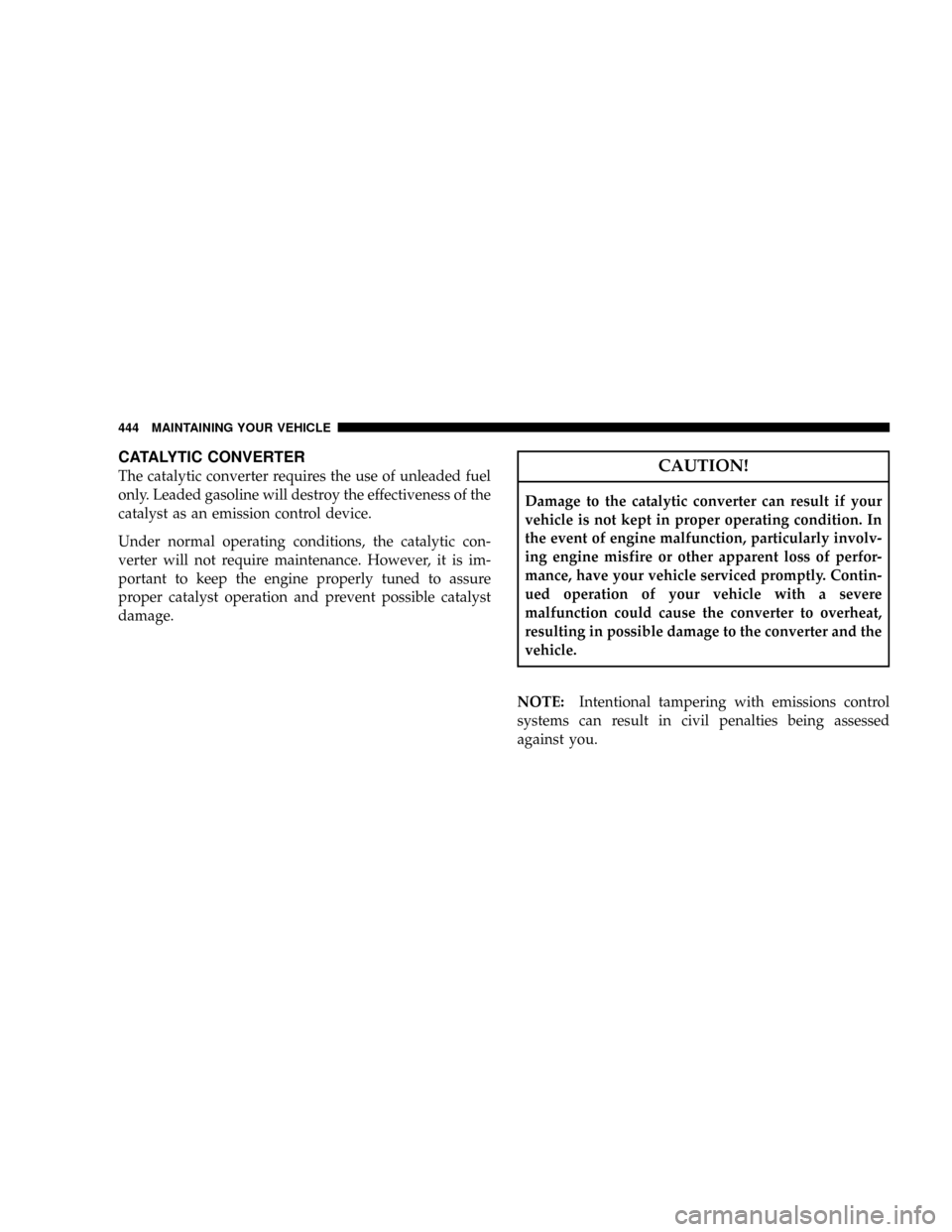
CATALYTIC CONVERTER
The catalytic converter requires the use of unleaded fuel
only. Leaded gasoline will destroy the effectiveness of the
catalyst as an emission control device.
Under normal operating conditions, the catalytic con-
verter will not require maintenance. However, it is im-
portant to keep the engine properly tuned to assure
proper catalyst operation and prevent possible catalyst
damage.CAUTION!
Damage to the catalytic converter can result if your
vehicle is not kept in proper operating condition. In
the event of engine malfunction, particularly involv-
ing engine misfire or other apparent loss of perfor-
mance, have your vehicle serviced promptly. Contin-
ued operation of your vehicle with a severe
malfunction could cause the converter to overheat,
resulting in possible damage to the converter and the
vehicle.
NOTE:Intentional tampering with emissions control
systems can result in civil penalties being assessed
against you.
444 MAINTAINING YOUR VEHICLE
Page 512 of 531
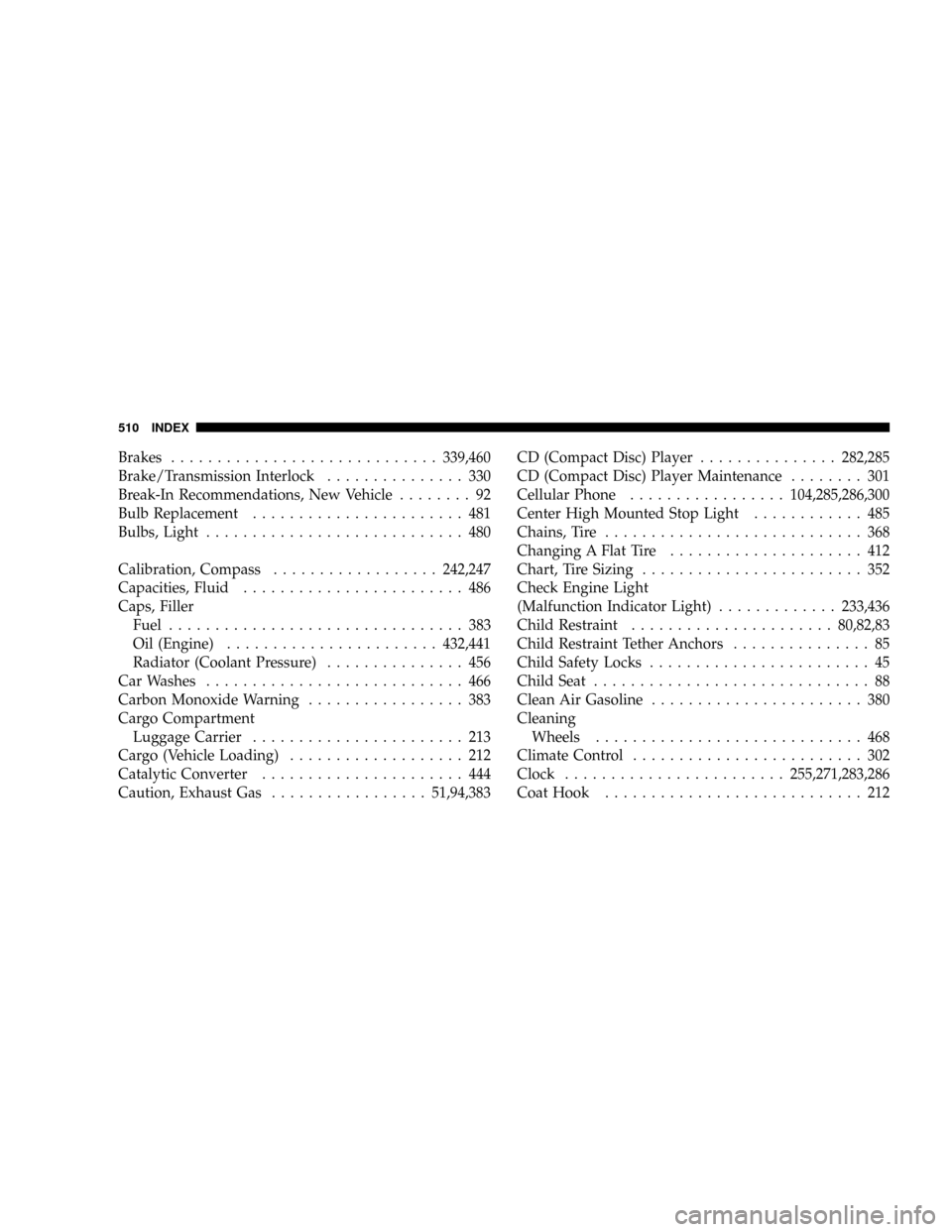
Brakes.............................339,460
Brake/Transmission Interlock............... 330
Break-In Recommendations, New Vehicle........ 92
Bulb Replacement....................... 481
Bulbs, Light............................ 480
Calibration, Compass..................242,247
Capacities, Fluid........................ 486
Caps, Filler
Fuel................................ 383
Oil (Engine).......................432,441
Radiator (Coolant Pressure)............... 456
Car Washes............................ 466
Carbon Monoxide Warning................. 383
Cargo Compartment
Luggage Carrier....................... 213
Cargo (Vehicle Loading)................... 212
Catalytic Converter...................... 444
Caution, Exhaust Gas.................51,94,383CD (Compact Disc) Player...............282,285
CD (Compact Disc) Player Maintenance........ 301
Cellular Phone.................104,285,286,300
Center High Mounted Stop Light............ 485
Chains, Tire............................ 368
Changing A Flat Tire..................... 412
Chart, Tire Sizing........................ 352
Check Engine Light
(Malfunction Indicator Light).............233,436
Child Restraint......................80,82,83
Child Restraint Tether Anchors............... 85
Child Safety Locks........................ 45
Child Seat.............................. 88
Clean Air Gasoline....................... 380
Cleaning
Wheels............................. 468
Climate Control......................... 302
Clock........................255,271,283,286
Coat Hook............................ 212
510 INDEX